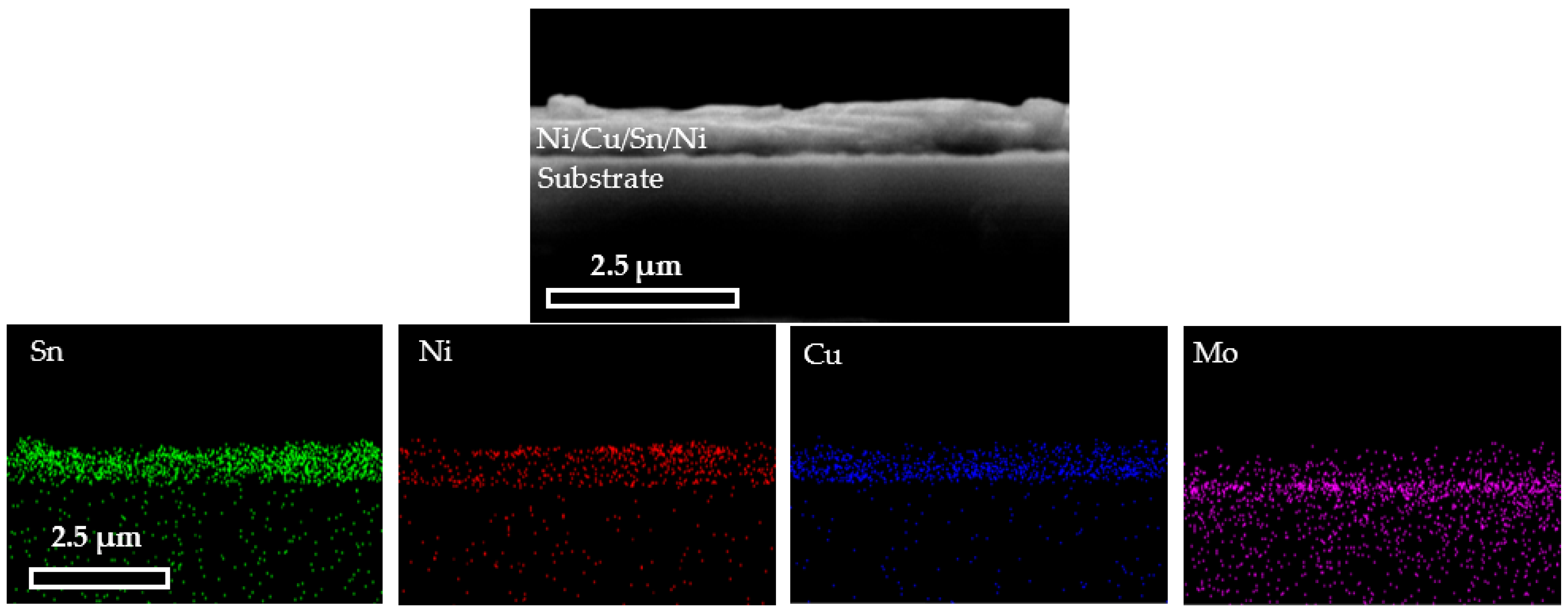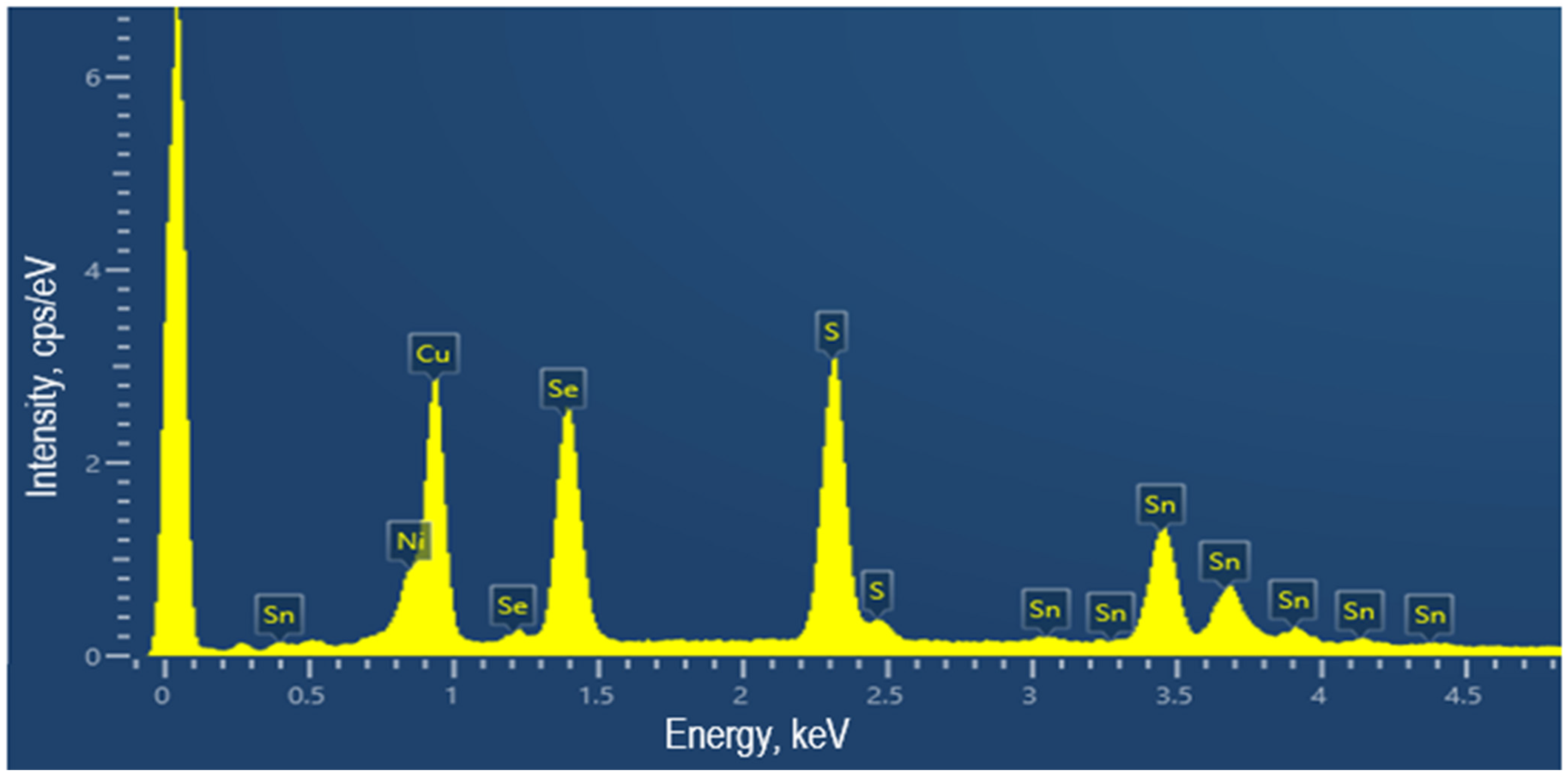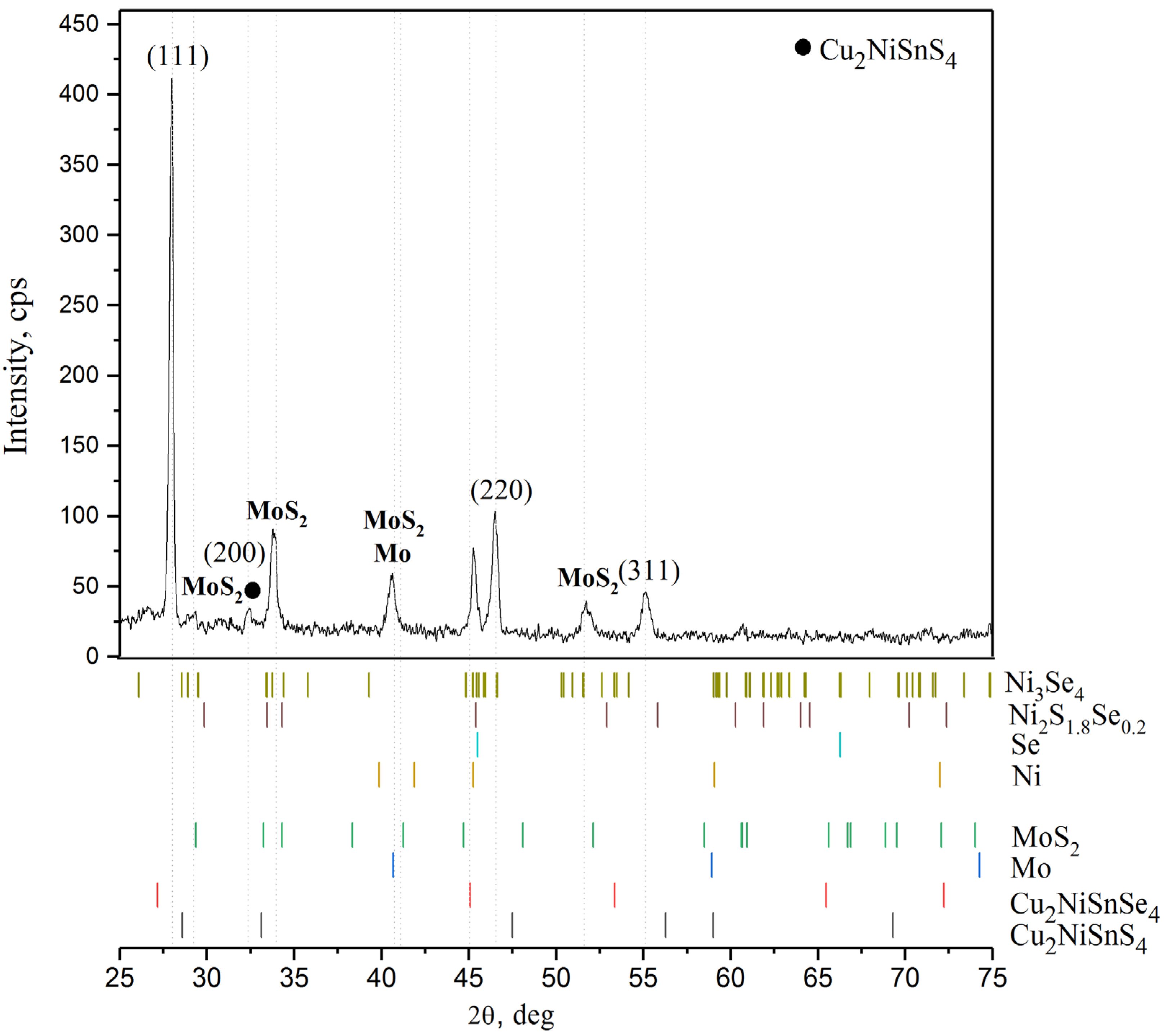Morphology and Crystal Structure of Cu2NiSn(S,Se)4 Thin Films Obtained by an Electrodeposition-Annealing Process
Abstract
:1. Introduction
2. Materials and Methods
2.1. Synthesis of Thin Films
2.2. Characterization Methods
3. Results and Discussion
3.1. Analysis of Morphology of Precursors
3.2. Analysis of Morphology of Thin Films
3.3. X-Ray Analysis of Thin Films
4. Conclusions
- (1)
- The Ni/Cu/Sn/Ni precursors had a uniform distribution of the deposited metal layers. The EDX mapping images showed a mutual diffusion of sequentially applied elements, which may indicate the formation of a binary or ternary intermetallic compound in the precursors.
- (2)
- It has been found that subsequent annealing in chalcogen vapor in air at 580 °C for 30 min makes it possible to obtain stable polycrystalline CNTSSe films.
- (3)
- The CNTSSe films crystallized in a cubic structure. The films had small deviations from stoichiometry in the cation as well as an anion sub-lattice. The diffraction peaks from the CNTSSe on the X-ray patterns were between the positions of the peaks from CNTSe and CNTS. The calculated unit cell parameter for CNTSSe (a = 0.551(7) nm) was between the values for CNTSe and CNTS, and was closer to the values for CNTS. This was due to the higher content of sulfur in the films than that of selenium. Using X-ray diffraction, along with the CNTSSe main phase and CNTS phase, the presence of the Ni2S1.8Se0.2 or Ni3Se4 phase was detected. No characteristic peaks corresponding to other impurities such as Cu(S,Se), Sn(S,Se) or Cu2Sn(S,Se)3 were observed at the detection limit of the XRD apparatus. This shows the phase purity and good quality of the films.
- (4)
- Annealing of the precursors led to an increase in their thickness from 700 to 900 nm to ~2.4 μm due to the insertion of sulfur and selenium atoms in the crystal lattice. It was found that the surface of the CNTSSe films is a homogeneous structure with densely packed large crystals and single pores.
Author Contributions
Funding
Institutional Review Board Statement
Informed Consent Statement
Data Availability Statement
Conflicts of Interest
References
- Green, M.A.; Dunlop, E.D.; Hohl-Ebinger, J.; Yoshita, M.; Kopidakis, N.; Hao, X. Solar cell efficiency tables (version 59). Prog. Photovolt. 2022, 30, 3–12. [Google Scholar] [CrossRef]
- Alzahrani, G.S.; Alzahrani, F.S.; Ahmed, M. Nahhas Study of the Specific Factors Effecting the PV Solar Cell’s Efficiency in Saudi Arabia. Sustain. Energy 2022, 8, 6–11. [Google Scholar] [CrossRef]
- Moskowitz, P.D.; Fthenakis, V.M. Toxic Materials Released from Photovoltaic Modules During Fires. Health Risks. Sol. Cells 1990, 29, 63–71. [Google Scholar] [CrossRef]
- Green, M.A. Estimates of Te and In prices from direct mining of known ores. Prog. Photovolt. Res. Appl. 2009, 17, 347–359. [Google Scholar] [CrossRef]
- Stanchik, A.V.; Gremenok, V.F.; Juskenas, R.; Tyukhov, I.I.; Tivanov, M.S.; Fettkenhauer, C.; Shvartsman, V.V.; Giraitis, R.; Hagemann, U.; Lupascu, D.C. Effects of selenization time and temperature on the growth of Cu2ZnSnSe4 thin films on a metal substrate for flexible solar cells. Sol. Energy 2019, 178, 142–149. [Google Scholar] [CrossRef]
- Stanchik, A.V.; Tivanov, M.S.; Tyukhov, I.I.; Juskenas, R.; Korolik, O.V.; Gremenok, V.F.; Saad, A.M.; Naujokaitis, A. Temperature dependence of Raman scattering in the Cu2ZnSnSe4 thin films on a Ta foil substrate. Sol. Energy 2020, 201, 480–488. [Google Scholar] [CrossRef]
- Li, X.; Zhuang, D.; Zhang, N.; Zhao, M.; Yu, X.; Liu, P.; Weiab, Y.; Renab, G. Achieving 11.95% efficient Cu2ZnSnSe4 solar cells fabricated by sputtering a Cu–Zn–Sn–Se quaternary compound target with a selenization process. J. Mater. Chem. 2019, 7, 9948–9957. [Google Scholar] [CrossRef]
- Shockley, W.; Queisser, H.J. Detailed balance limit of efficiency of p-n junction solar cells. J. Appl. Phys. 1961, 32, 510–519. [Google Scholar] [CrossRef]
- Tampo, H.; Kim, S.; Nagai, T.; Shibata, H.; Niki, S. Improving the open circuit voltage through surface oxygen plasma treatment and 11.7% efficient Cu2ZnSnSe4 solar cel. ACS Appl. Mater. Interfaces 2019, 11, 13319–13325. [Google Scholar] [CrossRef]
- Taskesen, T.; Neerken, J.; Schoneberg, J.; Pareek, D.; Steininger, V.; Parisi, J.; Gütay, L. Device Characteristics of an 11.4% CZTSe Solar Cell Fabricated from Sputtered Precursors. Adv. Energy Mater. 2018, 8, 1703295. [Google Scholar] [CrossRef]
- Ghosh, A.; Thangavel, R.; Rajagopalan, M. First-Principles Study of Structural Stability and Optical Properties of Cu2XSnY4 (X = Fe, Co, Ni; Y = S, Se) for Photovoltaic Applications. Energy Environ. Focus 2014, 3, 142–151. [Google Scholar] [CrossRef]
- Ozel, F.; Sarılmaz, A.; Istanbullu, B.; Aljabour, A.; Kus, M.; Sonmezoglu, S. Penternary chalcogenides Cu2MSn(SeS)4 (M= Zn+2 and Co+2) nanocrystals as catalytic materials for efficient counter electrodes in dye-synthesized solar cells. Sci. Rep. 2016, 6, 29207. [Google Scholar] [CrossRef] [PubMed]
- Yüksel, O.F.; Ozel, F.; Akın, Ü.; Tugluoglu, N. Structural, optical and dispersion studies on Cu2NiSn(SSe)4 nanocrystals thin films. Phys. B Condens. Matter 2022, 625, 413530. [Google Scholar] [CrossRef]
- Rondiya, S.; Wadnerkar, N.; Jadhav, Y.; Jadkar†, S.; Haram, S.; Kabir, M. Structural, Electronic, and Optical Properties of Cu2NiSnS4: A Combined Experimental and Theoretical Study toward Photovoltaic Applications. Chem. Mater. 2017, 29, 3133–3142. [Google Scholar] [CrossRef]
- Ghosh, A.; Chaudhary, D.K.; Biswas, A.; Thangavel, R.; Udayabhanuc, G. Solution-processed Cu2XSnS4 (X = Fe, Co, Ni) photo-electrochemical and thin film solar cells on vertically grown ZnO nanorod arrays. RSC Adv. 2016, 6, 115204–115212. [Google Scholar] [CrossRef]
- Khattak, Y.H.; Baig, F.; Soucase, B.M.; Beg, S.; Gillani, S.R.; Ahmed, S. Efficiency enhancement of novel CNTS/ZnS/Zn(O,S) thin film solar cell. Optik 2018, 171, 453–462. [Google Scholar] [CrossRef]
- Hameed, T.A.; Cao, W.; Abdelrazek, E.M.; El Zawawi, I.K.; Mansour, B.A.; Elsayed-Ali, H.E. Effect of substrate temperature on properties of Cu(In,Ga,Al)Se2 films grown by magnetron sputtering. J. Mater. Sci. Mater. Electron. 2015, 27, 3209–3216. [Google Scholar] [CrossRef]
- Hameed, T.A.; Cao, W.; Mansour, B.A.; Elzawaway, I.K.; Abdelrazek, E.-M.M.; Elsayed-Ali, H.E. Properties of Cu(In,Ga,Al)Se2 thin films fabricated by magnetron sputtering. J. Vac. Sci. Technol. A Vac. Surf. Film. 2015, 33, 031201. [Google Scholar] [CrossRef]
- Volobujeva, O.; Bereznev, S.; Raudoja, J.; Otto, K.; Pilvet, M.; Mellikov, E. Synthesis and characterization of Cu2ZnSnSe4 thin films prepared via a vacuum evaporation-based route. Thin Solid Films 2013, 535, 48–51. [Google Scholar] [CrossRef]
- Broussillou, C.; Viscogliosi, C.; Rogee, A.; Angle, S.; Grand, P.P.; Bodnar, S.; Debauche, C.; Allary, J.L.; Bertrand, B.; Guillou, C.; et al. Statistical Process Control for Cu(In,Ga)(S,Se)2 electrodeposition-based manufacturing process of 60 × 120 cm2 modules up to 14.0% efficiency. In Proceedings of the 42nd Photovoltaic Specialists Conference (PVSC), New Orleans, LV, USA, 14–19 June 2015. [Google Scholar] [CrossRef]
- Rosoiu, S.P.; Costovici, S.; Moise, C.; Petica, A.; Anicai, L. Electrodeposition of ternary Sn-Cu-Ni alloys as lead-free solders using deep eutectic solvents. Electrochim. Acta 2021, 398, 139339. [Google Scholar] [CrossRef]
- Kondrotas, R. Electrochemical Deposition of Cu-Zn-Sn Precursor and Formation of Cu2ZnSnSe4 Solar Cell. Ph.D. Disserster, Vilniaus Universitetas, Vilnius, Lithuania, 2015; 153p. [Google Scholar]
- Hansen, R.M. Adherent Electroplating on Molybdenum. Ph.D. Thesis, Newark College of Engineering, Newark, NJ, USA, 1952; 41p. [Google Scholar]
- Miettinen, J. Thermodynamic description of the Cu–Ni–Sn system at the Cu–Ni side. Calphad 2003, 27, 309–318. [Google Scholar] [CrossRef]
- Juškėnas, R.; Niaura, G.; Mockus, Z.; Kanapeckaitė, S.; Giraitis, R.; Kondrotas, R.; Naujokaitis, A.; Stalnionis, G.; Pakštas, V.; Karpavičienė, V. XRD studies of an electrochemically co-deposited Cu-Zn-Sn precursor and formation of a Cu2ZnSnSe4 absorber for thin-film solar cells. J. Alloy. Compd. 2016, 655, 281–289. [Google Scholar] [CrossRef]
- Copper-Nickel Alloys: Properties, Processing, Applications. Available online: https://www.copper.org/applications/marine/cuni/properties/DKI_booklet.html (accessed on 18 July 2022).
- Isacfranklin, M.; Yuvakkumar, R.; Ravi, G.; Hong, S.I.; Shini, F.; Thambidurai, M.; Dang, C.; Velauthapillai, D. Marigold flower like structured Cu2NiSnS4 electrode for high energy asymmetric solid state supercapacitors. Natureresearch 2020, 10, 19198. [Google Scholar] [CrossRef] [PubMed]
- Dridi, S.; Bitri, N.; Mahjoubi, S.; Chaabouni, F.; Ly, I. One-step spray of Cu2NiSnS4 thin films as absorber materials for photovoltaic applications. J. Mater. Sci. Mater. Electron. 2020, 31, 7193–7199. [Google Scholar] [CrossRef]
- Aitelhaj, D.; Elkissani, A.; Elyaagoubi, M.; Aitdads, H.; Welatta, F.; Nkhaili, L.; Chaib, H.; Outzourhit, A. Development of Cu2NiSnS4 based thin film solar cells without a sulfurization step. Mater. Sci. Semicond. Process. 2020, 107, 104811. [Google Scholar] [CrossRef]
- Dehghania, Z.; Shadrokh, Z. Structural and optical properties of Cu2M(M: Zn, Fe, Co, Ni)SnSe4 nanoparticles synthesized via heating up method. Int. J. Light Electron. Opt. 2018, 169, 242–248. [Google Scholar] [CrossRef]
- Cui, Y.; Deng, R.; Wang, G.; Pan, D. A general strategy for synthesis of quaternary semiconductor Cu2MSnS4 (M= Co2+, Fe2+, Ni2+, Mn2+) nanocrystals. J. Dyn. Artic. 2012, 22, 23136. [Google Scholar] [CrossRef]
- Yang, C.L.; Chen, Y.H.; Lin, M.; Wu, S.L.; Li, L.; Liu, W.C.; Wu, X.S.; Zhang, F.M. Structural, optical and magnetic properties of Cu2NiSnS4 thin films deposited by facile one-step electrodeposition. Mater. Lett. 2016, 166, 101–104. [Google Scholar] [CrossRef]
- Beraich, M.; Taibi, M.; Guenbour, A.; Zarrouk, A.; Bellaouchou, A.; Fahoume, M. Synthesis of Tetragonal Cu2NiSnS4 Thin Film via Low-Cost Electrodeposition Method: Effect of Ni2+ Molarity. J. Electron. Mater. 2020, 49, 728–735. [Google Scholar] [CrossRef]
- Stanchik, A.V.; Baraishuk, S.M.; Zhygulin, D.V.; Pyatlitski, A.N.; Trukhanava, E.L.; Chumak, V.A. Phase composition and microstructure of Cu2ZnSn(S,Se)4 thin films. Proc. Fr. Skorina Gomel State Univ. 2021, 3, 143–149. [Google Scholar]
- Stanchik, A.; Chumak, V.; Trukhanava, E.; Baraishuk, S. Crystal structure and optical properties of Cu2ZnSn(S,Se)4 thin films. BSPU Bulletin. Ser. 2021, 2, 13–19. [Google Scholar]
- Liu, T.; Diao, P.; Lin, Z.; Wang, H. Sulfur and selenium doped nickel chalcogenides as efficient and stable electrocatalysts for hydrogen evolution reaction: The importance of the dopant atoms in and beneath the surface. Nano Energy 2020, 74, 104787. [Google Scholar] [CrossRef]
- Awodugba, A.O.; Ibiyemi, A.A.; Ajayi, J.O. Effect of grain size on the electrical transport mechanism for zinc doped CdS thin films. Int. J. Sci. Res. Manag. Stud. 2014, 1, 234–241. [Google Scholar] [CrossRef]
- Daniela, T.O.; Unob, U.E.; Isahc, K.U.; Ahmadud, U. Optimization of electrical conductivity of SnS thin film of 0.2 <t ≤0.4 µm thickness for field effect transistor application. Rev. Mexic. Física 2021, 67, 263–268. [Google Scholar] [CrossRef]






| Elemental Composition, at.% | Ratio | ||||||
|---|---|---|---|---|---|---|---|
| Cu | Ni | Sn | Se | S | Cu/(Ni + Sn) | Ni/Sn | S/(S + Se) |
| 20.20 | 11.60 | 12.47 | 22.72 | 33.00 | 0.84 | 0.93 | 0.59 |
Publisher’s Note: MDPI stays neutral with regard to jurisdictional claims in published maps and institutional affiliations. |
© 2022 by the authors. Licensee MDPI, Basel, Switzerland. This article is an open access article distributed under the terms and conditions of the Creative Commons Attribution (CC BY) license (https://creativecommons.org/licenses/by/4.0/).
Share and Cite
Stanchik, A.V.; Asmalouskaya, T.N.; Rakitin, V.V.; Gremenok, V.F.; Gapanovich, M.V.; Trukhanova, E.L.; Zubar, T.I.; Trukhanov, A.V.; Trukhanov, S.V. Morphology and Crystal Structure of Cu2NiSn(S,Se)4 Thin Films Obtained by an Electrodeposition-Annealing Process. Coatings 2022, 12, 1198. https://doi.org/10.3390/coatings12081198
Stanchik AV, Asmalouskaya TN, Rakitin VV, Gremenok VF, Gapanovich MV, Trukhanova EL, Zubar TI, Trukhanov AV, Trukhanov SV. Morphology and Crystal Structure of Cu2NiSn(S,Se)4 Thin Films Obtained by an Electrodeposition-Annealing Process. Coatings. 2022; 12(8):1198. https://doi.org/10.3390/coatings12081198
Chicago/Turabian StyleStanchik, Aliona V., Tatsiana N. Asmalouskaya, Vladimir V. Rakitin, Valery F. Gremenok, Mikhail V. Gapanovich, Ekaterina L. Trukhanova, Tatiana I. Zubar, Alex V. Trukhanov, and Sergei V. Trukhanov. 2022. "Morphology and Crystal Structure of Cu2NiSn(S,Se)4 Thin Films Obtained by an Electrodeposition-Annealing Process" Coatings 12, no. 8: 1198. https://doi.org/10.3390/coatings12081198
APA StyleStanchik, A. V., Asmalouskaya, T. N., Rakitin, V. V., Gremenok, V. F., Gapanovich, M. V., Trukhanova, E. L., Zubar, T. I., Trukhanov, A. V., & Trukhanov, S. V. (2022). Morphology and Crystal Structure of Cu2NiSn(S,Se)4 Thin Films Obtained by an Electrodeposition-Annealing Process. Coatings, 12(8), 1198. https://doi.org/10.3390/coatings12081198







